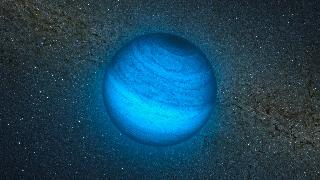
Artist's impression of the free-floating planet CFBDSIR2149. Photo: European Southern Observatory.
WASHINGTON (PTI): Astronomers for the first time have discovered a young "homeless planet", up to seven times the size of Jupiter and with no gravitational ties.
The lonely planet, called CFBDSIR2149 at the moment does not orbit a star. It is the first isolated planet of its kind ever to be discovered by scientists, after more than a decade of searching in a process described as looking for a single needle in amongst thousands of haystacks.
"Although theorists had established the existence of this type of very cold and young planet, one had never been observed until today," said tienne Artigau, an astrophysicist at University of Montreal (UdeM).
The absence of a shining star in the vicinity of this planet enabled the team to study its atmosphere in great detail. This information will in turn enable astronomers to better understand exoplanets that do orbit stars.
Free-floating planets are planetary-mass objects that have no gravitational link to a star.
"Over the past few years, several objects of this type have been identified, but their existence could not be established without scientific confirmation of their age," said Jonathan Gagne, a doctoral student of physics at UdeM.
"Astronomers weren't sure whether to categorise them as planets or as Brown dwarfs. Brown dwarfs are what we could call failed stars, as they never manage to initiate nuclear reactions in their centres," Gagne said in a statement
Researchers were able to find this planet with the assistance of French astronomers.
The planet is in fact called CFBDSIR2149 and appears to be part of a group of very young stars known as the AB Doradus Moving Group.
"This group is unique in that it is made up of around thirty starts that all have the same age, have the same composition and that move together through space. It's the link between the planet and AB Doradus that enabled us to deduce its age and classify it as a planet," researcher Lison Malo explained.
Researchers obtained a series of infrared images of CFBDSIR2149 using the 3.6 metres in diameter CFHT. They then used the full strength of the 8 metres in diameter VLT to deduce its mass, its temperature, and of particular note, its age.
The planet was found to be between 50 and 120 millions years old, with a temperature of approximately 400 degrees Celsius, and a mass four to seven times that of Jupiter.
 Next Article
Next Article













The Indian Air Force, in its flight trials evaluation report submitted before the Defence Ministry l..
view articleAn insight into the Medium Multi-Role Combat Aircraft competition...
view articleSky enthusiasts can now spot the International Space Station (ISS) commanded by Indian-American astr..
view article